World’s Healthcare Facilities

Disclaimer: Copyright infringement not intended.
Context
- Half of the world’s healthcare facilities lack basic hygiene services, putting 3.85 billion people at an increased risk of infections- Joint Report of World Health Organization (WHO) and United Nations Children’s Fund (UNICEF).
Findings
- Half of the world’s healthcare facilities do not provide patients with water, soap, or alcohol-based hand rubs.
- Around 3.85 billion people rely on these facilities and 688 million receive care at facilities with no hygiene services at all.
- The coverage of water, sanitation and hygiene (WASH) facilities is still uneven across different regions and income groupings.
- Only 51 per cent of healthcare facilities met the requirements for basic hygiene services.
- Some 68 per cent of them provided facilities for handwashing with water and soap at restrooms and 65 per cent had such amenities at points of care. Furthermore, just one in 11 medical facilities worldwide has both.
Situation in Sub Saharan countries
- In sub-Saharan Africa, facilities are falling behind in terms of hygiene services. Some 73 per cent of healthcare institutions in the region provide alcohol-based hand rubs or water and soap at points of care. But, only 37 per cent of restrooms have handwashing stations with water and soap.
Situation in Least developed Countries (LDCs)
- Only 53 Per cent of healthcare institutions in the least developed countries have access to safe water supply.
Situation in Eastern and South-Eastern Asia
- The proportion for eastern and south-eastern Asia is 90 per cent, with hospitals performing better than smaller healthcare facilities. Some 11 per cent of the rural and 3 per cent of urban healthcare institutions lacked access to water.
Concern
- Hospitals and clinics without safe water and basic hygiene and sanitation services are a potential death trap for pregnant mothers, new-borns and children.
- Every year, a whopping 670,000 newborns lose their lives to sepsis. Sepsis is a potentially life-threatening condition that occurs when the body’s response to an infection damages its own tissues. This is a travesty — even more so as their deaths are preventable.
- Unhygienic hands and environment significantly influence disease transmission in healthcare facilities and the emergence of antibiotic resistance.
Conclusion and Way Ahead
- Hygiene facilities and practices in health care settings are non-negotiable. Their improvement is essential to pandemic recovery, prevention and preparedness.
- Hygiene in healthcare facilities can be secured only by increasing investments in basic measures, which include safe water, clean toilets and safely managed healthcare waste.
- Countries need to implement their 2019 World Health Assembly commitment to strengthen water, sanitation and hygiene (WASH) services in health care facilities.
- Promoting access to handwashing with water and soap and cleaning is essential for providing high-quality health care, especially for safe deliveries.




1.png)
